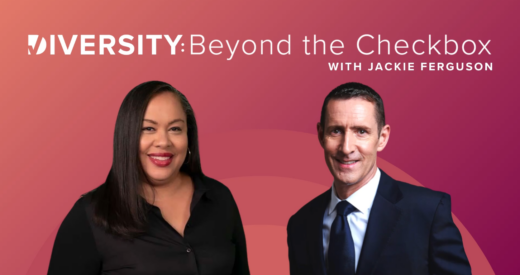You can’t win the game if you’re standing still. It’s an obvious point, but an essential one in our rapidly changing business environment. Highly successful executives are always looking for ways to improve themselves and their organization. They constantly ask, “What’s working? Where can we improve? What’s next?”
This attitude is the essence of a growth mindset, and it’s a clear competitive advantage. Senior leaders who are open to new ideas are more likely to take risks that pay off, adapt quickly to new challenges, and leverage the power of their diverse workforce.
For me, having a growth mindset is the single greatest skill that motivates and governs all other skills. I often describe this outlook as “competitive learning,” but the concept is the same – to push toward continuous improvement, to seek out mentors and coaches who will help you grow, and to embrace the fact that you can always get better.
As corporate executives, our success hinges on our ability to innovate quickly, synthesize information, and make decisions (frequently with limited scope). We cannot know which skills will make the crucial difference in each day’s success, so we must continually search for new and stronger ideas. By constantly refreshing our personal skill set, we can immediately apply the insights we have learned to spark critical thinking, meaningful change, and ongoing success.
Vulnerability and the Growth Mindset
A growth mindset should be in every inclusive leader’s toolkit, but some people still struggle to optimize this important leadership trait. Companies regularly promote individuals into management roles because of their knowledge, experience, and skill. These high-achievers may be reluctant to admit that they aren’t the smartest person in the room. They might also be slow to seek advice or appreciate different viewpoints.
But leaders who close themselves off to new ideas are only hurting themselves and their long-term prospects. The secret to high performance is to balance personal confidence with the vulnerability to acknowledge any gaps in expertise. Executive coach Nils Vinje, founder of B2B Leaders Academy, encapsulates this point with his advice to clients: “Don’t have all the answers.”
“The higher up you go, the more responsibility you have, the fewer answers you should have,” he says. “When you have all the answers, you immediately close off your world. So, don’t have all the answers. Instead, be curious, find out more, learn from others, and be open to any and all alternative ideas. You will see incredible answers come forth that you never could have imagined by yourself.”
Of course, leaders have strong opinions and ideas, but they also leave room for new information. You can drive toward your goals, yet still have humility and respect for other people’s contributions. A leader with a growth mindset can be strong-willed, but not stubborn; assertive, but not aggressive; self-assured and confident, but always open to new ideas.

Build Your Growth Mindset Through Collaboration
Being a growth-oriented leader means actively fostering a culture of teamwork, critical thinking, and inclusion. Often that means being the strongest facilitator in the room, not the person with the loudest voice. They believe wholeheartedly that “the best idea wins,” which spurs collaborative thinking.
One of the most effective ways to drive innovation and gather the data for better decision-making is by leveraging the contributions of diverse groups. Make sure the team includes individuals with a variety of backgrounds, world views, and perspectives. You’ll be a stronger leader if you surround yourself with people who inspire you and challenge you to grow – and then listen to and respect their input.
Collaborating with people who possess a growth mindset can significantly improve your own outlook. Seek out individuals who have complementary skills and expertise that you would like to tap. Meet regularly with smart people, particularly those who will talk about ideas and will take the time to listen to your thoughts. These conversations can be an important catalyst for your personal and professional growth. Engaging in these discussions not only broadens your thinking, but will inspire you to explore new horizons, challenge conventional wisdom, and embrace diverse approaches.
5 Ways to Cultivate a Growth Mindset Throughout Your Organization
When we develop our capacity for learning, we set the tone for a growth-focused culture that expects and rewards continuous improvement. To inspire your team and others throughout your organization, share what you are learning, openly and often. These opportunities help create trust and communicate an expectation for continuous growth across the organization.
Promoting a growth mindset will not only improve the efficiency and productivity of your team, but the attitude will also feed an inclusive workplace culture. According to the Harvard Business Review, employees who work at organizations that value and promote a growth mindset are 34% more likely to feel a strong sense of ownership and commitment to the company. These are the teammates most likely to help you create a stronger workplace culture and act as ambassadors for your company in the community.
Here are five actionable tips to help you promote continuous improvement, spark creative thinking, and encourage calculated business risks:
- Assign outside reading: Emerging leaders have an incentive to improve, so give your team articles or books that describe different ways of decision-making and problem-solving. One classic text is “Six Thinking Hats,” which explores how to investigate an issue from a number of perspectives and move beyond habitual ways of thinking.
- Ask probing questions: One of the best ways to facilitate a growth mindset is by asking, “What’s next?” The question will push your team out of their comfort zone, encouraging them to move beyond what they think they’re capable of. Other questions to promote innovation are: “Is there a better way?” or “Is this the best use of our time?”
- Establish a protocol for expansive thinking: As an inclusive leader, you can encourage the free exchange of ideas by making brainstorming a part of every meeting. There is immense value in using 10 or 15 minutes to explore radical thinking and progressive ideas. The regular habit of sharing out loud will spark innovation and curiosity, which lead to better business outcomes.
- Create a psychologically safe environment: People might be reluctant to share suggestions or a new approach, because they don’t trust their team or they aren’t self-confident. To promote a growth mindset, there should be zero tolerance for retaliation, criticism, or ridicule. Make it clear that everyone is expected to contribute and every idea will be considered with respect.
- Create a feedback culture: Make feedback a regular part of your team’s process and use it as a tool to get the best results. However, negative comments can be challenging for individuals who are still developing a growth mindset. It’s your responsibility to coach your team to see criticism as a learning opportunity. By creating a culture of ongoing dialogue – top-down, bottom-up, and peer-to-peer – you cultivate a growth mindset in your team.
By making a growth mindset part of your team’s everyday operations, you can help build a culture of continuous improvement and innovation that will propel your organization forward and ensure long-term success. By engaging in ongoing learning and discovery, your organization will be able to stay on the pulse of customer needs and behaviors.
Join the ranks of forward-thinking organizations that are harnessing the power of inclusive leadership to build stronger executive and managerial teams. Contact us today to learn how TDM LeaderView can transform your team and allow your organization to thrive.
Donald Thompson, EY Entrepreneur Of The Year 2023 Southeast Award winner, is a globally respected business leader, CEO of The Diversity Movement, CDE, and author of Underestimated.




